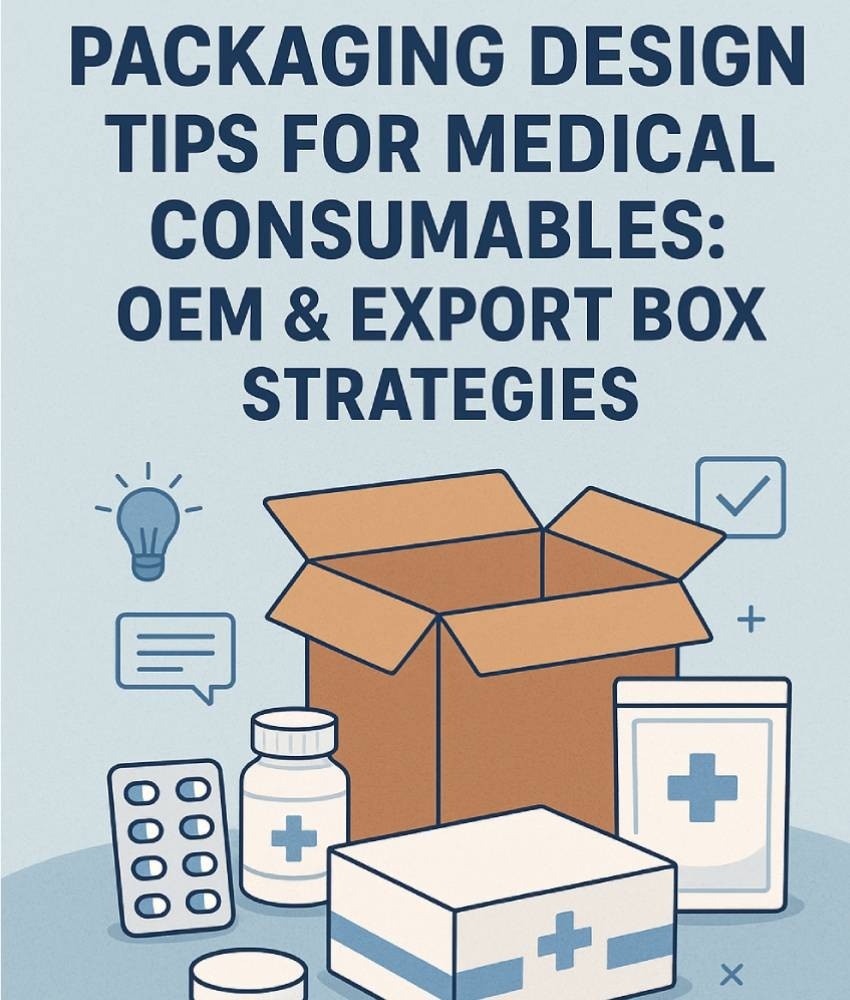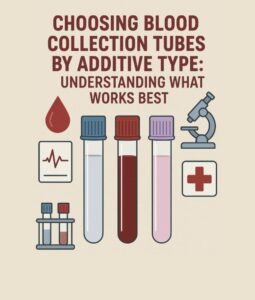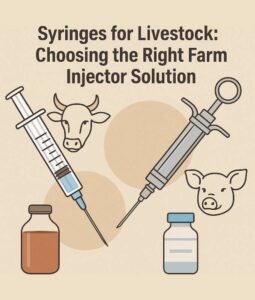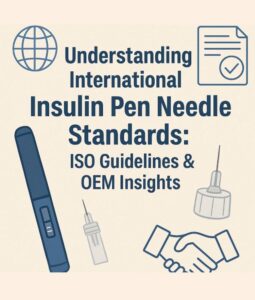Introduction to Medical Consumable Packaging
When it comes to international healthcare logistics, medical packaging design, insightful OEM package tips, and compliant export box medical solutions aren’t just about appearance—they’re crucial for protecting patient safety, maintaining regulatory compliance, and enhancing brand credibility. Whether you’re a manufacturer, distributor, or OEM partner, getting your packaging right is just as important as the product itself.
From syringes and wound dressings to dialysis sets and insulin pen needles, medical consumables require packaging that’s functional, durable, and professionally branded—especially when destined for global markets. Know more..
What is Medical Packaging Design?
Elements of Functional and Aesthetic Design
Medical packaging design is the process of developing packaging that ensures sterility, protects products from damage, and communicates key usage and compliance information. A well-designed package must:
- Provide barrier protection from moisture and contaminants
- Be tamper-evident and child-resistant (where applicable)
- Include clear instructions, symbols, and labeling
It should also reflect the brand’s values, whether clean and clinical or bold and modern.
Material Selection and Sterility Assurance
Common medical packaging materials include:
- Medical-grade paper and polyfilm for pouches
- PET or PVC for blister packaging
- Corrugated board for cartons
Sterility compatibility with EO, Gamma, or Steam sterilization is non-negotiable. Each packaging layer must withstand high heat and pressure without compromising integrity.
OEM Package Tips for Medical Device Brands
Custom Branding and Labeling Options
OEM package tips often focus on:
- Private labeling with your company logo and product name
- Color-coded boxes for quick product identification
- Instruction for Use (IFU) in multiple languages
- Custom shapes and inserts for better product presentation
This helps your medical brand stand out while remaining compliant with global regulations.
Regulatory Considerations for OEM Packages
Make sure your OEM partner complies with:
- ISO 13485 packaging protocols
- FDA 21 CFR Part 820 for device labeling
- CE marking and EU MDR packaging directives
All packaging should include accurate lot numbers, expiry dates, and manufacturing details.
Designing the Right Export Box for Medical Products
Export Box Medical Standards and Specifications
An export box medical solution must protect products during transit and meet international shipping guidelines. Your box should be:
- Strong enough for stacking (burst strength: 275 lb+)
- Water-resistant with laminated or waxed coatings
- Clearly labeled with handling and orientation indicators
Carton Strength, Waterproofing, and Label Placement
Label areas should include:
- Product name and quantity
- Gross/net weight
- Country of origin
- Shipping and storage instructions
- Compliance symbols (e.g., fragile, temperature-sensitive)
Always follow GS1 guidelines if barcoding is required.
Balancing Protection and Presentation
Visual Branding vs. Functionality
Great packaging delivers both. Don’t compromise protective performance for flashy design. Instead:
- Use bold fonts and contrast for readability
- Choose clean layouts and icons that guide users
- Reinforce brand colors through box interiors and pouch trims
How to Minimize Damage During Shipping
- Use foam inserts or molded trays
- Apply shock sensors or temperature indicators on the carton
- Select double-walled boxes for international air or sea freight
Primary vs. Secondary Medical Packaging
Blister Packs, Pouches, and Inner Wrappers
Primary packaging is in direct contact with the consumable. It should:
- Be sterile and sealed
- Include easy-open features (e.g., tear notches)
- Withstand drops and compressions
Outer Cartons, Shrink Wraps, and Pallets
Secondary and tertiary layers ensure:
- Batch tracking
- Safe storage and stacking
- Moisture and UV protection in storage
Shrink wrap on bundles can reduce shifting during transit and save warehouse space.
Printing Guidelines for Medical Packaging
Language, Fonts, and Compliance Marks
Always use legible fonts (minimum 6 pt) and include:
- UDI codes (Unique Device Identifier)
- Regulatory marks: CE, FDA, ISO, etc.
- Expiry and manufacture dates
- Country-specific icons (e.g., Do Not Reuse, Keep Dry)
Lot Numbering, Expiry Dates, and Traceability Codes
These are critical for recalls and inventory management. Ensure:
- Numbers are indelible and heat-resistant
- QR or 2D barcodes are scannable after sterilization
- GS1 standards are used if shipping globally
Eco-Friendly Packaging Trends in Healthcare
Sustainable Packaging Materials
Modern medical packaging design increasingly uses:
- Recycled paperboard
- Biodegradable blister trays
- PLA films derived from plant starches
Sustainability is becoming a major selling point for hospitals and procurement teams.
Biodegradable and Recyclable Options
Ask your OEM or box supplier about:
- Compostable pouch liners
- Water-based inks
- Minimalist packaging to reduce waste
Labeling Compliance Across Regions
EU MDR, FDA, and ISO Label Requirements
Each region has specific rules:
- EU MDR requires language localization and risk classification
- FDA mandates device identifier, date formatting, and warnings
- ISO 15223-1 standardizes labeling symbols globally
Barcodes, UDI Codes, and International Symbols
UDI codes are mandatory for many Class I–III devices. Labels must feature:
- GS1 barcodes
- Temperature handling
- Latex or allergen information
OEMs should integrate this info during pre-print proofing.
Sterilization Compatibility and Packaging Integrity
EO, Gamma, and Steam Sterilization Packaging
Each sterilization method requires:
| Sterilization Type | Packaging Requirement |
| Ethylene Oxide (EO) | Gas-permeable pouches |
| Gamma Radiation | UV-resistant plastic films |
| Steam | Heat-sealed wraps, water-proof labels |
Make sure packaging material tests include burst and tensile strength post-sterilization.
Seal Strength and Moisture Barriers
- ASTM F88 testing for seal strength
- ASTM F1929 testing for seal leaks
- Use aluminum foil laminates or PET layers as moisture barriers
MOQ and Supply Chain Tips for OEM Packaging
Optimizing Production Runs and Cost per Unit
- Consolidate SKUs into standardized box sizes
- Print in bulk to reduce per-unit cost
- Consider digital printing for low-volume customization
Partnering with Reliable Print and Box Suppliers
Look for:
- ISO 9001-certified packaging vendors
- Experience in medical-specific box design
- Global shipping logistics and tracking support
Inspection and Quality Assurance Protocols
Packaging Testing and Drop Test Guidelines
Every export box medical configuration must pass:
- Drop testing from 1.2 meters
- Burst strength testing
- Vibration and stacking simulations (ASTM D4169)
Carton Validation and Regulatory Inspection Prep
- Keep samples of each batch for audits
- Use tamper-evident tape or stickers
- Store packaging in temperature-controlled zones
FAQs About Medical Packaging for Export and OEM
1. What’s the best material for sterile medical pouches?
Tyvek® and medical-grade paper with poly film are common for EO or Gamma sterilization.
2. How do I make sure my packaging is FDA-compliant?
Follow 21 CFR Part 820. Label must include UDI, manufacturer, and clear instructions.
3. What should be printed on an export box medical carton?
Product name, lot number, weight, handling symbols, and destination country.
4. Can I customize packaging if I’m an OEM buyer?
Yes. Most medical device manufacturers offer custom colors, logos, and inserts.
5. How do I test packaging durability for long-distance shipping?
Use ISTA drop tests, burst strength ratings, and seal integrity tests post-sterilization.
6. What’s the MOQ for OEM packaging runs?
It varies but is typically 5,000–10,000 units depending on print complexity and packaging type.
Conclusion
A strategic approach to medical packaging design, incorporating expert OEM package tips and robust export box medical standards, is critical for success in today’s global medical device market. By focusing on protective performance, regulatory compliance, branding, and sustainability, you can elevate your packaging from a basic necessity to a competitive advantage.
Whether you’re launching a new line of disposable syringes, diabetic pens, or infusion sets, partner with experienced suppliers who understand international standards and can guide you through the design, testing, and printing process.






